How to clear a clogged sewer pipe at home: solutions + tips for prevention
Not every homeowner knows how to clear a clogged sewer pipe at home. Not everyone knows how to do this work quickly and efficiently, especially if this is the first time they have encountered this problem. Any problems with sewerage are stressful for the owners, especially persistent congestion, right?
We will help you solve this problem. The article we presented describes in detail methods for determining the location of a traffic jam and proven methods for getting rid of it. To help independent plumbers, there are photo and video recommendations for cleaning pipes using improvised means.
The content of the article:
Causes of sewer blockage
If you find that the water is not draining well and there is an unpleasant odor, then the clog that has formed is to blame. The smaller the problem, the easier and simpler it is to get rid of it. Therefore, first you need to determine the cause of the garbage jam.
Problem #1 - accumulated fat
Fat from dishes settling on the walls of pipes causes the majority (about 70%) of traffic jams.Most often, such a blockage appears in the kitchen: the sink and dishwasher drain are the most problematic areas.
Such accumulations form slowly: their inner layer is jelly-like, and the outer layer, adjacent to the pipes, is more compacted. They are formed, in addition to fat, food particles, threads, etc.
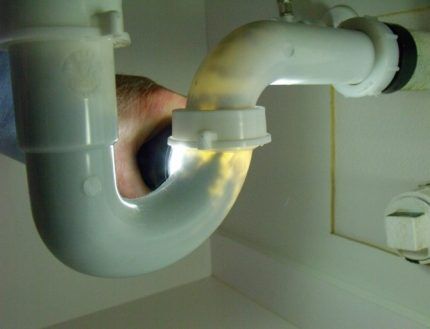
Problem #2 - heavy waste
Heavy particles provoke the appearance of man-made blockages. Of the total number of causes, they make up no more than 10% and appear most often in apartment buildings.
The following are considered heavy: sand, debris from renovations, poorly flushed solutions, pet litter, hygiene products, rags, wet wipes, toilet paper and newspapers that fall into the sewer through the toilet.
In addition, organic waste - vegetable peelings, onion peels, food particles - can “organize” a mechanical plug in the pipes. Often the causes of blockages can be children's toys - elements Lego, beads and any small objects that accidentally fell into the sewer.
Clogged siphon is often the key cause of blockages, both in the kitchen and in the toilet. It needs to be cleaned approximately once every 2-3 months.
Problem #3 - getting hit by hard objects
Pipe damage can cause a blockage due to solid particles of different sizes entering the system. For example, a piece of wood, plastic, which can get stuck somewhere in the middle of the pipe.
There, other debris and fat will be layered on top of this item. It is they who will provoke the growth of a large traffic jam, which is not so easy to break through.In a private home, the cause may be deformation of a pipe adjacent to the main sewer, or external pressure from a large object.
Problem #4 - unprofessional installation
Unprofessional installation of sewer pipes in an apartment or house can create big problems for the owners in the form of frequent blockages.
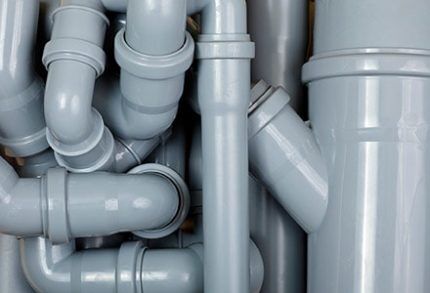
For example, installing pipes at too sharp an angle, or, conversely, at an insufficient slope; a large number of creases, too small a cross-section of pipes, gaps between pipes, incorrectly selected parts or the absence of them.
Problem #5 - service life and maintenance
Long service life of pipes can cause blockages. But PVC pipes are practically not subject to such wear.
This is more true for cast iron pipes, since their inner surface has some roughness. It is susceptible to corrosion and is left with residue from passing debris and sewage. Over time, sediment accumulates and is compressed, so the permeability of the pipes will decrease.
Lack of necessary maintenance and routine cleaning of plumbing is also a common cause of traffic jams. For cast iron pipes, such cleanings must be carried out once every 2-3 months, and for plastic pipes - at least once a year. Having determined the cause of the blockage, it is necessary to find out its location.
Location of the blockage
Finding out the exact location of the plug is important in order to choose the right product for sewer pipe cleaning. First, you need to open all the taps: in the bathroom, in the kitchen, in the shower, and flush the toilet.Where the water does not drain well into the pipes, a characteristic odor will appear, and a plug will form there.
If water stagnates in one place: for example, in the kitchen sink or in the toilet, then this is a local problem, but if the water does not flow well at all points, then the entire system is clogged.
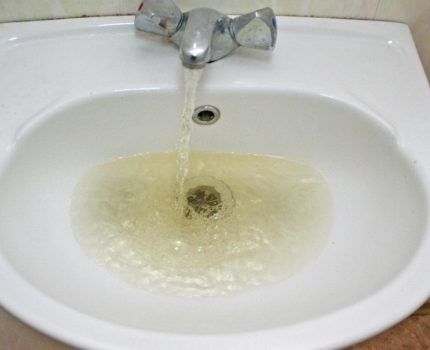
Having decided on the location and cause of the blockage, let's consider how to deal with traffic jams.
Methods and means for cleaning
Depending on the degree of contamination and the location of the blockage, we will help you choose a working method. Next we will talk about folk, chemical and mechanical ways to clean drains.
Folk remedies for quick cleaning
Try pouring 2-3 liters of boiling water into the sink if the problem is only a stuck bar of soap. To quickly clear more complex clogs, but not compressed grease or dirt, you can use different soda-based mixtures. Before using this mixture, first clean the surface of the drain and wipe it dry.
Soda and salt. Pour a dry mixture of salt and soda (1/2 cup each) into the drain and leave for at least 10 hours, or better yet, overnight.
Soda and vinegar. Mix half a cup of vinegar and the same amount of soda, the resulting mixture should be carefully poured down the drain, block it with a stopper and leave for at least 40 minutes, a maximum of several hours.
When you add vinegar, immediately close it with the cap. If you cannot achieve maximum tightness, the result will be zero. After cleaning in this way, be sure to flush the drain plenty of hot water.
Soda and boiling water. Dilute 1 cup of soda in 3 cups of boiling water and pour this solution into the drain hole.
Calcined soda. Heat 150 g of baking soda for 15 minutes in a cast iron frying pan. Then cool and dilute with cold water, pour the resulting mixture into the drain. After 2 hours, rinse with boiling water.
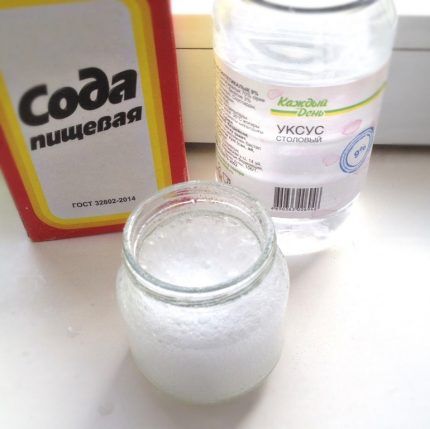
Also, ordinary washing powder can cope with minor blockages. Pour 2-3 scoops or 1 cup of powder into the drain and run hot water for 5 minutes, or you can just pour in 2 buckets of hot water. If all else fails, then use store-bought products.
Fast acting chemicals
If you need quick results, use household chemicals. There is a wide range of products available on store shelves that can be used to clean the drains in your home.. Such preparations can be: acidic and alkaline, dry or in granules, gels and liquids.
Read the instructions carefully before purchasing, because different products are used for different types of pipes and blockages. Pay attention to the manufacturer's recommendations - if this is a preventive product or only against fatty plugs, then do not use it in other cases. Otherwise, you risk damaging or completely ruining your sewer or plumbing fixtures.
Products with alkali will help get rid of grease blockages in the kitchen, while acidic substances are more used for garbage plugs in the bathroom. After all, here the cause of a clogged drain is usually soap or hair.
Which drain cleaner Whatever you choose, be sure to take precautions: use gloves, do not lean over the drain when pouring the drug. Never use acidic and alkaline products at the same time.
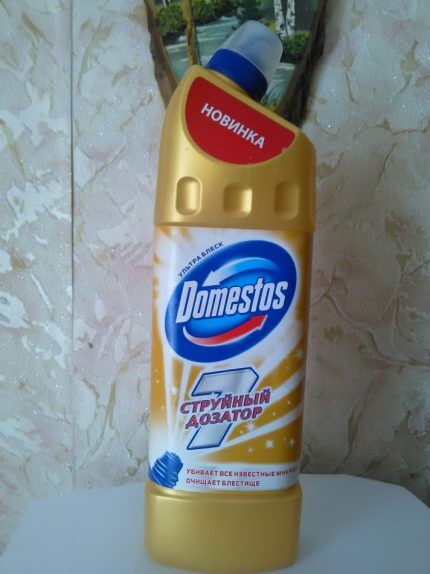
Here are some of the most popular drugs to combat different types of traffic jams:
- Mole and its variations - turbo or professional, gel or proshok. A universal remedy that is perfect for both prevention and removal of existing blockages. You can pour it in or fall asleep overnight, leaving the window open.
- Tiret Turbo - according to customer reviews, it copes best with grease plugs in the kitchen. Has a pungent odor.
- Domestos - this “universal soldier” is familiar to every housewife. It can be left on all night. Suitable for all pipes and sinks, in addition to plugs, kills germs and plaque.
- Mister Muscle - a universal drug that copes with any traffic jams. Its active substances act quite quickly - about 1-2 hours, although experts recommend pouring it in overnight. There is no smell or dangerous fumes.
- Bugs Pothan - a powerful chemical that can cope even with old traffic jams. It must be used with the utmost caution due to the active reaction and pungent odor: pour in at arm's length with a glove, turn your head away, and put on a mask. If you have allergies, then it is better not to use this drug.
When using any of the described means, be sure to equip yourself with rubber gloves and, if possible, a protective mask.Also, do not overexpose the drug beyond the specified time, because this will only harm the pipes.
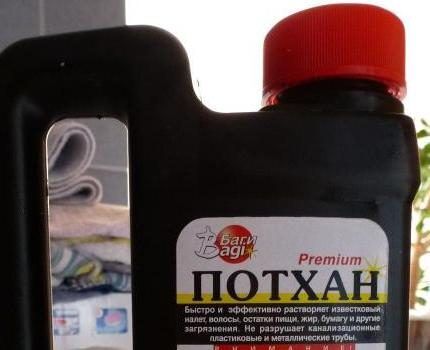
After working with any chemicals, be sure to ventilate the room. If after using such preparations the water still does not go away, then use plumbing products.
Review of technical methods
If neither traditional methods nor chemicals have helped to cope with sewer congestion, then all that remains is to test technical methods. These products include plumbing tools that will help deal with blockages of any complexity.
Method No. 1 - use a plunger
This simple device consists of a rubber bowl and a wooden handle. If two sinks are installed, then two plungers must be used simultaneously. When there is no second plunger, close the other drain tightly with a damp cloth.
To clean, install the plunger so that it completely covers the drain, pour some water into the sink. Then you should vigorously move the handle up/down at least 10-15 times. After this, the water should completely merge with a characteristic sound. If this does not happen, then repeat your steps.
The plunger cannot be used on wall-mounted washbasins - they will not withstand pressure, and in addition, the device will not break through long-standing compressed clogs. How to remove it clogged sink drain, you will learn from the article we recommend.
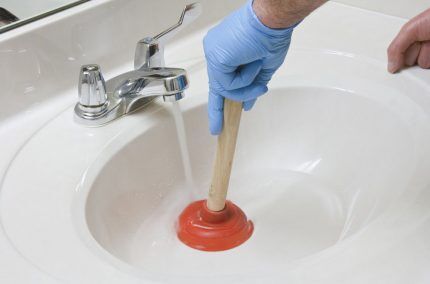
Please note that after such cleaning, the pipes must be further purify cable or chemicals and rinse with plenty of warm water.
Method No. 2 - cleaning the siphon
A standard bottle siphon has a diameter of 30-45 mm - the smaller it is, the faster it clogs. The removable part, which is shaped like a bowl, can be easily unscrewed.
Before cleaning the siphon, place a bowl of water under the sink and wear gloves. Then carefully unscrew it, using a special cable or wire to remove all excess. Wash the siphon, dry it and screw it into place. Check your work: you should pour water into the sink and if it goes away quickly, then there is no longer a blockage.
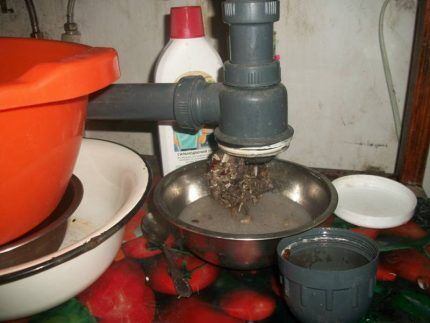
If you have a different type of siphon installed, for example, pipe, corrugated or triple, then proceed to the next method.
Method No. 3 - take a plumbing cable
If you have plastic pipes installed, then any plumbing cable should be used with extreme caution.
In other cases, follow these instructions:
- Place a basin or bucket under the sink.
- Separately, fill any container with water to clean the cable.
- Then unwind the siphon. Rinse and clean it.
- Grasp the cable handle; if there is none, make one from a bent ring.
- Insert the end of the device into the pipe. Then start rotating it slowly, pushing it deeper - to do this, rotate the handle. Do this as carefully as possible so as not to damage the pipe.
- At regular intervals, take it out and clean it of dirt in a pre-prepared container. If you come across a compaction, then this is a blockage.
- Screw in a clean and dry siphon.Check all details.
- Rinse the pipeline with boiling water.
Such simple, repeatable steps will help you deal with even compacted blockages.
If there is no cable, then as an alternative, you can use a thick wire, forming a hook at its end.
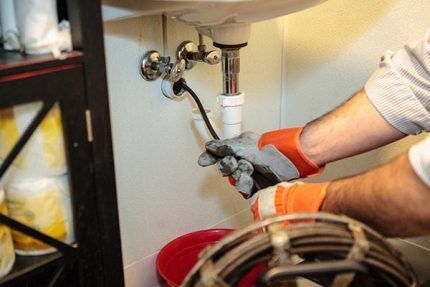
Sometimes the cable can be constructed from a metal hanger: using a tool, for example, wire cutters, you need to cut its ends so that you get a hook for removing dirt.
Method No. 4 - resort to hydrodynamics
This is the most effective method for “severe” cases. Only professionals use it. For example, for working with hard plugs in the middle of a pipe, for cleaning sewers in private homes or main sewers. A hydrodynamic professional device is used to clean pipes with a diameter of 5 to 150 mm.
Cleaning is carried out thanks to a tube with several types of nozzles for spraying water under high pressure - up to 200 atmospheres. Both hot and cold water are used.
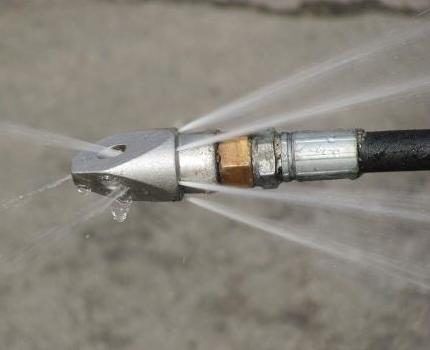
It’s up to you to decide which technical method of dealing with sewer waste you use. If the blockage is old or the pipes are very old, then use the all-in-1 method.
Method No. 5 - we solve the problem radically
A universal or prefabricated method will help in the fight against even the most “harmful” blockage. The method consists of several steps.
If the first one in sewer cleaning did not help, then proceed to the next one, and so on, until there is no trace left of the cork:
- preparation - drain the water, remove any leftover food and debris, dry the drain;
- pour baking soda and boiling water into a dry drain;
- use the plunger, then the cable;
- pour a chemical, for example, Mister Muscle or Mole, overnight;
- Pour a large amount of boiling water into the drain, about 1 bucket, or open the tap for a few minutes.
This method will almost certainly save you from this annoying problem.
How to protect your sewer from blockages?
Below we provide a few tips that will help avoid the formation of garbage jams in the future:
- Once every 2-3 months, do a light cleaning of the pipes with folk remedies or run boiling water through the pipes every day at the end of the day.
- Before washing dishes, remove leftover food from the plates, wipe off excess grease, and throw it in the trash.
- Do not throw hygiene products, wet and paper wipes, cat litter, sand, or inorganic waste into the toilet.
- Never clean shoes in a sink. Try to remove as much dirt as possible from above the trash can.
- After washing floors and very dirty surfaces, pour the water into the toilet, but not into the sink.
- Place a bucket for paper in the toilet, do not waste water for flushing, and do not throw technical and construction waste into the toilet - glue, sand, cement, as well as large organic waste. To clean the toilet, use special anti-scaling products.
Pay attention to technical means that will protect pipes from garbage plugs.
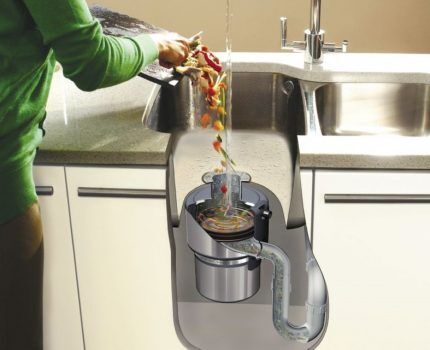
You should install special screens on each drain: kitchen sink, shower, bathtub. They will retain organic waste, partially fat, hair, sand, threads and other small objects.
To prevent the formation of fatty deposits, use a special device: grease trap. The device is produced for industrial and household use and consists of two sections. Operating principle: wastewater passing through the filter system in the first container is cleared of large debris. In the second, special filters clean the water from fat.
To grind organic waste, install under the sink garbage grinder. It is mounted under the sink, connected to the sewer and connected to the network. The device can work instead of a siphon. It is recommended to place the socket not under the sink to protect it from getting wet.
Compact garbage grinder will cope with all waste, from vegetable trimmings, seeds, to poultry and fish bones. Do not throw hair, pieces of fabric, or wool into it, otherwise the device will simply break.
All described technical devices are meshes, grease trap, garbage grinder, After use, wash thoroughly and keep clean.
He will introduce you to the methods and technological features of eliminating blockages in the toilet bowl. next article, in which all the options tested in practice are analyzed and described in detail.
Conclusions and useful video on the topic
Video #1. How to prevent blockages using improvised means:
Video #2. Learn how to properly use a plunger to clean pipes:
Video #3. The cable is the first assistant for cleaning sewers in cottage:
Video #4. How to use a cable to clean a drain in an apartment:
Now you know how to deal with any type of blockage not only in an apartment, but also in a private house. Sometimes you will need to use several methods to achieve the desired result. But armed with our simple tips, you can easily overcome the difficulties that arise.
Please write comments in the block below, ask questions and post photos on the topic of the article. Tell us about how you were able to quickly and effectively get rid of a clog in your sewer system. It is possible that you have a special method known only to you that is worth sharing with site visitors.




Several sections advise using boiling water (with or without additives?). I would like to understand how safe this is for plastic pipes and siphons? For example, I had a case when a plastic part (faucet/shower switch) in a faucet melted and became deformed. After that incident, I am somehow wary of too hot water.
It's absolutely safe. Plastic pipes confidently hold temperatures up to 140 degrees, and begin to melt at 175. That is, they can only be melted with water in a vapor state, and boiling water will not cause harm.
All this cleaning of kitchen siphons is not particularly difficult. But cleaning at the junction with the public access and apartment pipes can be problematic. By the way, I was puzzled by the advice that suggests cleaning cast iron sewer pipes every 2-3 months.I would like some clarification: how is it possible to disassemble them, or what? If you plan to pour some kind of “Mole” into them, then it will simply leak away without in any way cleaning the walls of the pipe.
As for cast iron, it all depends on the layers that form in it over many years of use. If you do not clean a cast iron pipe for many years, there will be a couple of centimeters of deposits in it, which will almost completely block the flow of water. Here, any remedy will do the trick. The only thing that will help is punching it with a cable, or even better, hydraulic punching. But if as a preventive measure, then the mole will do an excellent job of removing minimal fat deposits in both plastic and cast iron.
Hello! It will leak if you continue to pour water while rinsing the pipe of the product. But if you pour it in overnight, for example, it will linger and dissolve on small blockages, which are precisely what causes the accumulation of large deposits. It is also recommended to rinse with hot water. If you do not flush large household waste, napkins and toilet paper down the drain, then such preventive measures will last a long time.